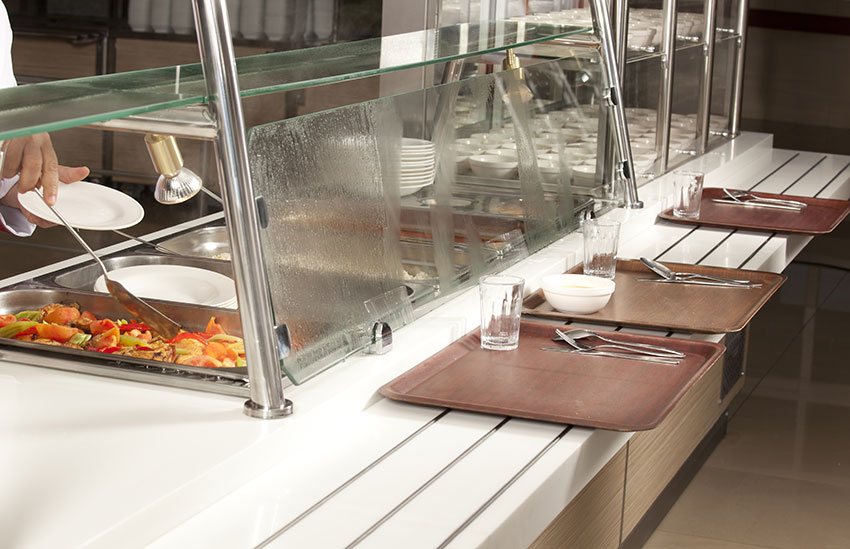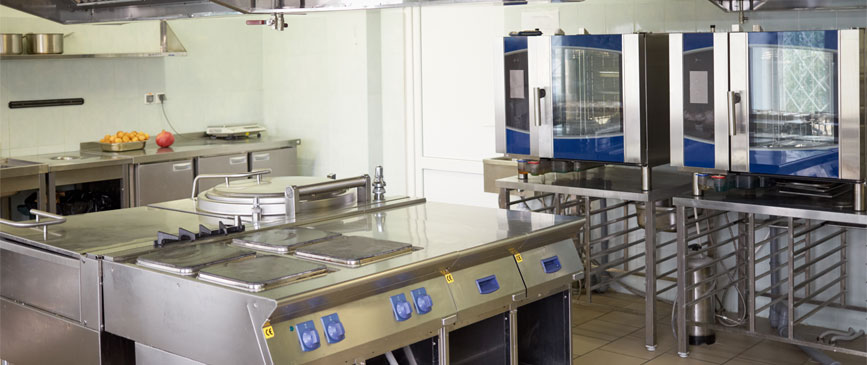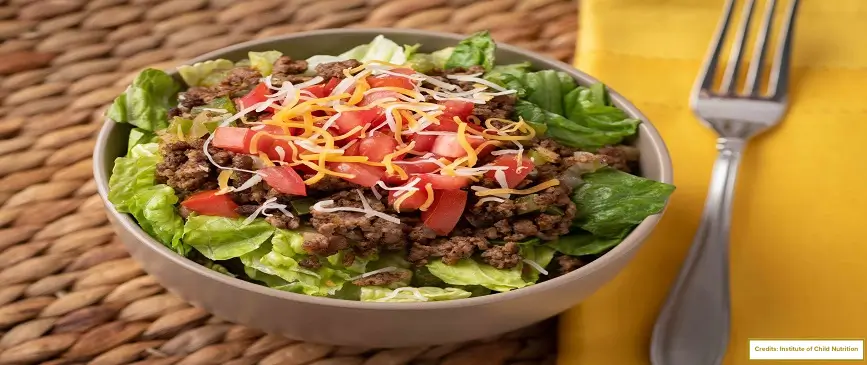 The heart and soul of a K-12 cafeteria design lies in the kitchen. Whether you are laying the foundation of a brand new school’s new lunchroom, expanding on an existing one or looking to remodeling it, you should have the parameters that define an efficient student dining area chalked out in front of you. Designs that have exemplary layouts and stand out from the rest, typically include kitchens that are fully equipped with everything the staff needs within easy limits. A school dining facility’s success is crucial to the way it is organized and the level of industrial integration that goes into it to facilitate workflow and in turn improving efficiency manifold.
The heart and soul of a K-12 cafeteria design lies in the kitchen. Whether you are laying the foundation of a brand new school’s new lunchroom, expanding on an existing one or looking to remodeling it, you should have the parameters that define an efficient student dining area chalked out in front of you. Designs that have exemplary layouts and stand out from the rest, typically include kitchens that are fully equipped with everything the staff needs within easy limits. A school dining facility’s success is crucial to the way it is organized and the level of industrial integration that goes into it to facilitate workflow and in turn improving efficiency manifold.
What comes to your mind when you think of a “school cafeteria’s kitchen”? The most common perception (for some) would be to picture a kitchen with ovens, sinks, a few grills and ranges.However, for an efficient and smooth working kitchen to prepare a satisfactory K-12 meal (for student consumers) it is essential that it is planned well. K-12 cafeteria aesthetics is something that transforms the entire student dining experience and gets students coming back to the table.Let’s look into some of the major components of an ideal cafeteria kitchen design.
Let’s Get Started: Ask a Chef
Why inquire with the experts? Involving chefs in your kitchen and getting their feedback in the school’s dining areas’ design process would be a sensible thing to do as they are the chief operators in the retail industry’s kitchen. Include these chefs in contributing to future K-12menus. Two heads are better than one! Trust their decision-making ability to know what will work for your kitchen. The design should incorporate a kitchen that helps the back-of-the-house team to operate to its maximum capacity. Even though the input from the designers and front-end team matter too, chefs can give you decent ideas to help you achieve maximum productivity.
Menu Planning
The requirements of a K-12 cafeteria is unlike any other foodservice operation. The time restraints and mass number of students relying on the school meal, makes serving breakfast and lunch (in schools) rather unique. For this reason, menu writers must take careful consideration when developing recipes for the K-12 market. Hence, knowing what’s on your menu can be a great help in deciding the type of kitchen layout you would want to opt for. Understanding the importance of the menu being central to the K-12 cafeteria design process, can speed things up and bring you closer to the ideal kitchen layout.
For example, in your new design, if you want to compete with the retail establishments students frequent outside of the school day by offering a stir-fry or live-cooking station to freshly prepare school breakfast and lunch for your student customers, the kitchen layout should be such that it supports the whole idea and ensures it runs smoothly.
Flexibility and Space Efficiency
Just like your menu tries to cater to a diverse array of taste buds, your kitchen space should be as equally flexible as your menu. If you have menu cycles that include everyday specials or Grab ’N Go options, having a kitchen that is segmented, with mobile points of sale (POS) and/or multipurpose workstations is the best way to utilize your space to the maximum.
Ergonomic Design
Attention to detail could practically make or break your cafeteria kitchen concept.Conceptualizing and adhering to a kitchen design layout that has an ergonomic design is all about placing things in your kitchen that prioritizes the comfort and convenience of foodservice staff, of all levels.
Higher prep tables, an under counter freezer, proper lighting, an energy efficient system all come together to make the perfect kitchen design layout. Your staff will appreciate knowing you considered their comfort during the process of designing and arranging their K-12 workplaces.Incorporating products and systems so that they fit the people who use them, is a win-win for all parties.
Components of a K-12 Cafeteria Kitchen
When figuring out how to enhance your K-12 cafeteria aesthetics during the planning phase it is essential that one takes every minute detail into consideration. With the kitchen being the engine of any dining establishment, it is imperative that it is designed with maximum convenience in mind, incorporating all the components of a highly functional, as well aesthetically appealing setting.
Cleaning and Storage Space
In order for the kitchen space to work out for both the back-end staff as well as the front-line staff, it is imperative that the washing, cleaning and storage spaces are discretely defined. Be it cold storage, dry storage or non-food storage, everything should go to their proper places. A separate section for the clean dishes right next to the washing area is suggested as it facilitates speedy work-flow.
Cold storages help preserve perishable items that need to be duly refrigerated or frozen, whereas dry storages deal with non-perishables and hence each serves their respective purposes.
Let’s get it all together: Food preparation
A K-12 cafeteria design that has a user-friendly food preparation area, properly segmenting the areas for washing, cutting and cooking the ingredients is sure to be a set-up for success. Having the storage area near the cutting (getting the vegetables, protein and other ingredients ready) and let’s say, the mixing area… allows staff to assemble the students’ meals in the minimum possible time and in a seamless manner with dirty dishes coming in from one side and the freshly prepared meals exiting from the other.
Meeting Food Safety, Hygiene and Sanitation Codes
After all the careful, thoughtful planning that goes into designing a highly functional kitchen, you wouldn’t want your kitchen’s design to undergo criticisms of any sort or not meet the expected standards set by the health codes and policies of the district, state or national level agencies.
While the cooking and the food preparation areas may seem to be the most important part of the kitchen, the cleaning stations are just as important to keep the entire place in proper shape.
Supervise and Train For Superior Customer Service
For student customers to have a holistic and satisfying dining experience it is imperative that all levels of staff be adequately trained and supervised to yield maximum productivity and efficiency. For this reason, a School Nutrition Director is placed in charge of the staff and regular training is provided to all levels of staff to mitigate any discrepancies and overcome the shortcomings that might be a hindrance in the overall efficiency of a K-12 dining establishment.
The importance of K-12 cafeteria aesthetics cannot be stressed enough as it goes a long way in determining the success and overall productivity of the cafeteria. Since student customers are our top priority it is important that all these specific details are considered and implemented effectively.
The K-12 cafeteria design is all about how each component contributes to the overall effectiveness of the cafeteria. From the lighting and flexibility to complying with food and health standards, all components should be given due importance. So, commit to designing the ideal K-12 school dining room and convert your student customers to loyal customers.


